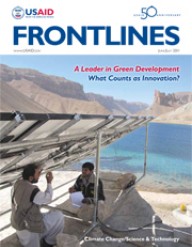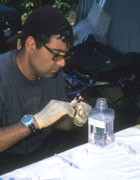I’m thrilled that FrontLines has highlighted science and technology in this edition. The articles within it discuss the great leaps forward we have made as an agency in just over a year to restore science and technology to its rightful place.
However, the new Office of Science and Technology at USAID, which I am extremely proud to direct, stands atop the shoulders of pioneering Agency scientists, technical specialists, and development visionaries who, early on in our history, made the Agency synonymous with game-changing, science-based advancements that improved the lives and livelihoods of millions around the world. We can restore that legacy again, and highlight the people at USAID who have continued that great work.
From our seminal role in introducing oral rehydration therapies, to promoting the eradication of polio and smallpox, to launching the “Green Revolution,” the Agency boasts a storied legacy of science and technology accomplishments. This is a technical agency at its core, where science helps us characterize the challenges we face as a global community, or provides tools and research to address them.
Reflecting on these early milestones only spurs us on to achieve even more powerful science and technology breakthroughs to benefit those most in need. More than ever, today’s quickly evolving science and technology developments—frugal innovations in medical diagnostics, life-saving vaccines, affordable off-grid energy sources, advancements in biotechnology, and fundamental research to increase agricultural yields with a smaller environmental footprint—hold the promise to make this a better world for all by cracking this century’s toughest challenges.
The range of articles in this FrontLines edition mirrors the many ways USAID’s science and technology push is making a difference: from tackling today’s toughest development challenges at their critical constraints (Grand Challenges for Development), to accelerating life-promoting product development with NASA (LAUNCH) and boosting agricultural productivity, to re-building internal science and technology capacity (AAAS Fellowship Overview); and from addressing over-the-horizon global trends (Futures) to using the latest tools and applications for spatial mapping and analysis (the GIS Repository).
However, this edition includes merely a handful of the science and technology initiatives and efforts that the Agency is commanding. Going forward, the real challenge will be to ensure that USAID continues to be the global leader employing science and technology to transform development and to empower 6 billion development experts to ultimately render development assistance obsolete. I hope you will join us in making USAID’s second half-century every bit as legendary as our first.
Alex Dehgan is science and technology adviser to USAID Administrator Rajiv Shah, and director of the Agency's Office of Science and Technology
See www.usaid.gov/unga for examples of USAID's science and technology history.










Comment
Make a general inquiry or suggest an improvement.